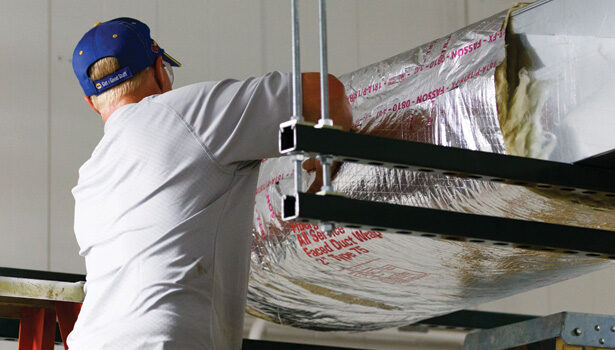But duct insulation is being used more and more during retrofit projects in an effort to make older homes and buildings more efficient. And since ductwork is often responsible for a significant amount of energy loss in a building, many contractors — especially those who specialize in home-performance contracting — are increasingly turning to duct insulation to help improve energy efficiency in their customers’ buildings.
Saving Energy
According to the U.S. Department of Energy (DOE), 30-40 percent of conditioned air leaks out of the average home’s ductwork before it reaches its intended destination, said Sam Rashkin, chief architect of the Building Technologies Office in the DOE’s Office of Energy Efficiency and Renewable Energy. “Newer homes will have tighter ducts,” Rashkin said, “but in older homes, heating and cooling is the No. 1 energy consumer.”
On the commercial side, duct-work is generally tighter, though it can still leak 20 percent or more. In addition to sealing ductwork — which can be done by hand with rolled mastic sealant or brush-on/spray-on sealants, or automatically by using Aeroseal’s technology — insulating a building’s ductwork is another important step contractors can take to make sure the hot or cold air inside the ductwork stays that way.
“Increasing people comfort in both new buildings and retrofits projects is a growing trend,” said Stacy Fitzgerald-Redd, director of communications at the North American Insulation Manufacturers Association (NAIMA). “One of the biggest human comfort needs is the ability to control the temperature of their home and work environment. The goal of an insulated duct system is to deliver air at design temperatures, which means making sure that the air gets to the room at the same temperature as it was when it left the air handler.”
Brian King, director of products and programs at Owens Corning, said building owners should definitely insulate their ductwork, adding that fiber glass duct wrap and duct liners are popular choices.
“There are lots of new ways to insulate, but we still feel that fiberglass continues to perform,” King said. “It’s durable and resistant to mold and fungus, and it’s been around for as long as it has because it’s great technology.”
Fitzgerald-Redd said the prevalence of un-insulated ducts is decreasing as engineers and building owners pay more attention to system performance, IAQ, and overall results.
“Improved occupant comfort and productivity are the primary human benefits to a healthy duct system,” she said. “We cannot reinforce enough the importance of proper system design, sizing, insulation selection, duct fabrication, installation, and routine maintenance to keep a healthy duct system truly healthy.”
Shhh, I’m Insulating
King said that in addition to cutting down energy loss in residential systems, duct insulation is being used more and more on the commercial side, too, but not just for the energy savings it provides.
“Schools and hospitals are both trying to be quieter, and that’s something that’s now being considered,” King said. “One way is to use wrap-around insulation, and another is to insulate the inside of the ductwork with duct liner, which gives you better acoustics, as well. You end up with much quieter duct systems.”
Fitzgerald-Redd agreed that many institutional building owners are beginning to see duct insulation as a cost-effective way to lower the noise level inside their buildings.
“Designing for improved acoustical performance — or the ability of the insulated ducts to absorb unwanted sound — in commercial buildings, such as schools and healthcare facilities, is on the rise,” she said. “Building owners want quiet, hassle-free systems that are more efficient, less costly, and result in tenants or employees who are more productive because of their indoor environment.”
A Great Opportunity
In addition to insulating existing ductwork in residential and commercial buildings, contractors are installing more insulated flexible ductwork in both new and retrofit projects.
“We’re seeing flexible duct media becoming much more popular in the retrofit environment,” King said. “It’s flexible, it’s insulated, and we’re definitely seeing that as a trend. It’s used both in new construction and retrofit projects, and it’s easy to install.”
Fitzgerald-Redd agreed, adding that and duct board is also gaining traction in the market.
“In certain regions, products such as fiber glass duct board and flexible duct are gaining popularity due to ease and cost to install, focused fabrication and installation training programs, and contractor and code official workshops,” she said.
At Unico Inc., a manufacturer of small-duct, high-velocity (SDHV) products, insulation is an important part of their product line, too. “We provide a range of insulated main trunk lines and flexible supply tubing, ranging from R4 to R8,” said Scott Intagliata, sales director at Unico. “All items are available as standard parts for our system.”
With many building and energy codes now requiring duct insulation and increased energy efficiency — and with building and energy codes only tightening in the future — many in the industry recognize the importance of installing duct insulation in buildings of all shapes, sizes, and purposes.
“Ductwork is a great opportunity to make buildings more efficient,” King said. “It’s an important topic.”
Fitzgerald-Redd agreed, saying, “Insulated ducts have always been, and will continue to be, a necessary component in a building’s air delivery system and an important part of an energy conservation program.”
Publication date: 10/21/2013
Want more HVAC industry news and information? Join The NEWS on Facebook, Twitter, and LinkedIn today!





Report Abusive Comment